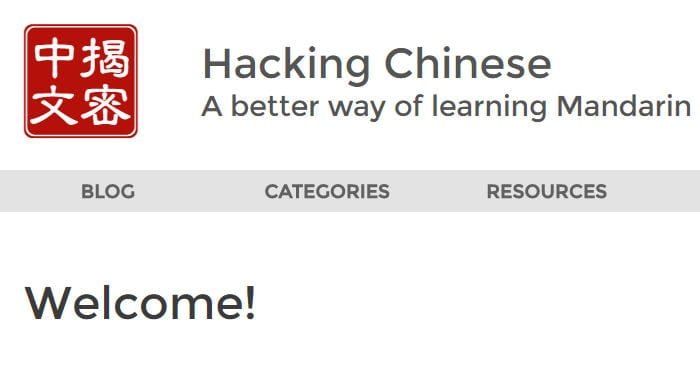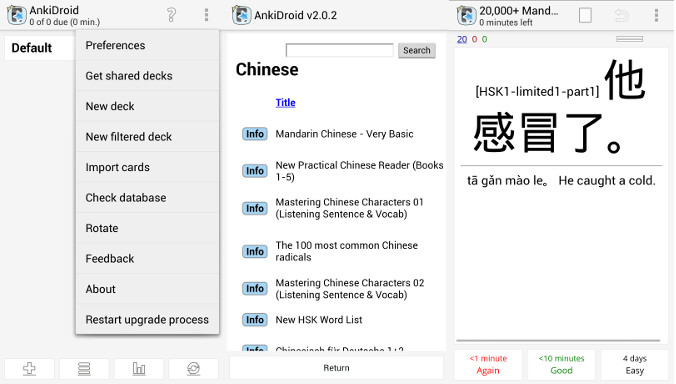
Today I want to talk about the new Chinese language courses “Hacking Chinese – A practical Guide to Learn Mandarin” and Unlocking Chinese – The ultimate course for beginners created by Olle Linge, author of the well-known blog, “Hacking Chinese.”
Who is Olle Linge and what is his philosophy on learning?
Olle Linge is a Swedish young man who, after studying for almost a decade, obtained a masters degree for teaching Chinese as a second language in Taipei. Besides teaching Chinese privately and managing “Hacking Chinese”, which is in my opinion one of the two or three best websites around, Olle has also created two courses that promises to teach you how to learn Chinese.
Olle sums up his philosophy on learning through an ancient proverb:
“授人以魚,不如授人以漁.”
“Give a man a fish and you feed him for a day. Teach a man to fish and you feed him for a lifetime.”
Based on this philosophy, the courses “Hacking Chinese” and “Unlocking Chinese” are not your typical courses presenting the basics of vocabulary, pronunciation, grammar, etc; rather it’s a compilation of strategies and tactics for learning Chinese in an effective manner.
Even though Olle doesn’t openly cite it, I think the course is an example – applied to the learning of Chinese – of the Pareto Principle, which is very simple:
“80% of the results are obtained through 20% of the efforts.”
The important question, therefore, when preparing yourself for learning Chinese (or just about any foreign language), is the following:
“How do I know which 20% of the activities will give me 80% of the results so that I can focus my available time for learning Chinese on these types of activities, learn as quickly as possible, and at the same time not get discouraged and stop studying?”
Look, if you had to summarize the courses in a single phrase, I would say that it answers the question that I just raised.
But obviously, there’s much more! Below I will explain what the two courses contain and how they’re structured.
How much do they cost and what do the “Hacking Chinese” courses offer?
The “Unlocking Chinese” course costs 97 USD and offers the following:
- A video course (more than 50 videos organized according to 5 subjects)
- A package of sentences with audio tracks (containing the 150 most used words in Chinese)
- Tools to improve pronunciation
- A community forum (to be able to discuss learning Chinese with other users)
- Discounts on various services and apps useful for learning Chinese.
Important: To ensure the quality of the course, registrations are limited, and open at different times for a period of 10 days. Click here to find out when the next registration period will begin.
The course “Hacking Chinese” costs 97 USD and offers instant access to:
- A video course (15 videos);
- An e-Book of 347 pages;
- The audio edition of the e-Book (read by Olle himself);
- Discounts on various services and apps useful for learning Chinese.
Note that Olle offers a 30-Day Money Back Guarantee from your date of purchase.
What is the structure of the “Unblocking Chinese” course?
The course for beginners or people with no knowledge of the language is structured in the form of five chapters (each of which contains links to the corresponding videos and a list of select resources to delve deeper into the subject covered):
Keys to learning Chinese
In my opinion, this introductory chapter is the most important one in the course. In it, the author discusses how to start learning Chinese on the right foot, which is essential if you want to be successful.
This section will help you to correctly analyze the reasons why you want to learn Chinese and what your goals should be. Besides, it will help you learn how to make the most of courses, textbooks, and Chinese lessons.
How to learn how to speak Chinese
This chapter is an extensive guide to Chinese phonetics including the following:
- Guide to dialects
- Guide to the written transcription of Chinese phonetics (Pinyin, Zhuyin and IPA)
- Guide to learning to pronounce and recognize tones
- Tricks for understanding a native speaker
- The importance of language immersion (at home or abroad)
- Tricks and tools for being able to practice your pronunciation with native speakers
How to learn vocabulary and sentences in Chinese
In this section, Olle teaches you some of the most useful techniques and tools for actually learning Chinese.
Learning any language is a huge exercise in memory, and Chinese is particularly difficult in this sense. However, some techniques can make your studying much more effective.
In this section, you will learn how to apply mnemotechnics to Chinese, what they are, how to use spaced repetition or SRS software, the correct way to build sentences and many other tricks to not sound like a foreigner, even if you translate sentences.
How to learn Chinese writing
While for beginners, Chinese writing may seem an impossible task, there is a logic behind Chinese characters.
This chapter teaches you how to structure and form Chinese characters, the logic behind characters, the correct way to write them and the best techniques for learning to recognize and write them.
Also, you will find useful techniques to be able to start to read in Chinese, even with limited knowledge of the language.
How to design your strategy for learning Chinese
This section is also an essential part of the course. Having a concrete plan is just as important as learning. Here, you will learn, through examples, how to design your learning plan so that it is compatible with your busy daily life and how to evaluate whether you meet the established goals.
How is the course “Hacking Chinese” structured?
Aside from the introduction, the course is divided into five chapters (for each you’ll find a link to corresponding videos and a list of resources chosen to deepen the particular theme):
Strategies for learning
In this chapter, using the metaphor of an adventure in the jungle, Olle explains how learning another language is a very personal journey that depends on your current level, situation and above all your final objective.
The chapter also explains how to maintain motivation in the long term, reducing as much as possible the negative feelings caused by learning Chinese that if faced “passively” will become extremely tedious.
To conclude, Olle lists the pros and cons of various methods for learning Chinese (at home, in school, the “kamikaze” approach, etc).
Characters, vocabulary and grammar
This chapter discusses the best methods for learning characters, vocabulary (contrary to what many beginners think Chinese characters do change meaning according to the characters that follow or proceed a given character) and grammar.
The chapter also explains how to learn and reviews two extremely different concepts such as software SRS that can help you optimize the time spent reviewing (but warning you that SRSs are not a panacea to cover all ills – another common misconception that I too was guilty of), and how wrong it is to try to remember 100% of what you learn.
The last part of the chapter is dedicated to mnemonic devices, which I too feel are fundamental if you want to avoid learning Chinese words through incredibly boring (and often useless) repetitions, and techniques for learning to write Chinese characters.
Improving in reading and listening to Chinese
This chapter covers techniques for bettering your ability to read and understand spoken Chinese. Olle – and I find myself in agreement, – believes that the “secret” is to read and listen to Chinese as much as possible.
The difficult thing is understanding how to do so since your time is limited. The chapter goes on to list various techniques for “immersing yourself” in reading and listening.
Want an example of the many suggestions you’ll find in this chapter? If you enjoy playing video games, try changing the language of your PlayStation to Chinese!
Improving in speaking and writing Chinese
This chapter is laid out similarly to the previous one, focusing instead on techniques for improving your ability to speak and write Chinese. What struck me the most was the part dedicated to the most common errors in pronunciation (perhaps because it has always been my weak spot).
Managing and planning your studies
This chapter is dedicated to techniques for maintaining motivation while learning Chinese, even if it seems you’re not progressing fast enough.
In my opinion, this is very important, because, for a Westerner, Chinese presents further difficulties as far as learning goes than, for example, learning French. Progress is, therefore, slower; and that requires greater effort in terms of “motivation”.
the “Hacking Chinese” course!



